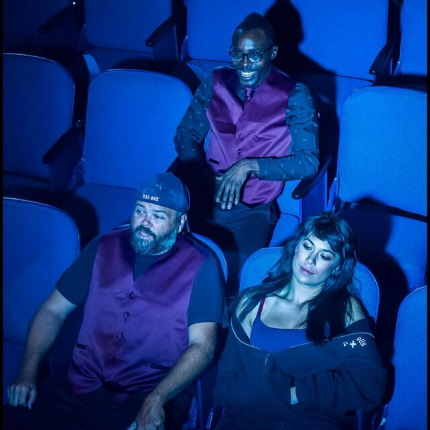
David Nail, Chevii Hill and Jessica Farr as employees taking a breather while cleaning up an old movie theater in The Flick at Mad Cat Theatre Company / Photos by George Schiavone
By Bill Hirschman
Sometimes critics use the words “ambitious” and “intriguing” as backhanded compliments or cowardly faint praise, but Mad Cat Theatre Company’s production of the Pulitzer-winning The Flick earns both adjectives as unironic compliments.
Now to say that this three-hour slice-of-life will not be to everyone’s taste is a supreme understatement. It can be argued honorably whether this theatrical Continental Divide is worth the effort. Some will find it stimulating, engaging and worth the investment, we certainly did. Many others will deem it self-consciously precious and uninvolving. To be brutally fair, the play doesn’t really catch fire until, no kidding, the 83-minute mark.
But if you meet the work way more than halfway, if you can slip yourself into the groove that playwright Annie Baker and director Paul Tei have carved out, there are rewards for the audience in this challenging work.
Any description of the show may be off-putting; it’s something that has to be experienced to be fairly judged because while there is a plot of sorts and relationships of sorts (the selling points for a potential audience), they’re pretty mundane. But that’s kind of the point. It’s a theatrical cinema-verite documentary of people who rarely get a moment in an artistic spotlight. It’s a testament to Tei’s deft direction and three winning performances that inexplicably keep a willing audience engaged and returning from the one intermission. Doubtless, few other companies than Mad Cat would have the courage to attempt nor have the skill to succeed with this work.
The Flick charts a few weeks in the world of two ushers with mops and brooms plus a projectionist, all doing menial drudgery at one of the last remaining single-auditorium movie theaters in Massachusetts still operating a 35mm projector. The year is 2012 and technology is taking over these decaying holdouts.
Sam (David Nail) is probably a bit past 30 years old, a solid stolid employee with no prospects other than this. He was recently passed over for the more prestigious projectionist job in favor of his slightly gothy colleague, the twenty-something Rose (Jessica Farr).
The play opens as Sam is training a newbie, Avery (Chevi Marquise Hill), a 20-year-old African American taking a semester off from college and – unlike his colleagues – a rabid film freak who can beat Six Degrees of Kevin Bacon from memory including drawing the line between Pauly Shore and Ian Holm. He loves celluloid, but many classic films like Goodfellas he has seen only on his computer screen.
It’s indicative of much of the play that the first 15 minutes or so is watching these two guys clean up the theater aisle by aisle with silences broken up tidbits of technical advice, grunts upon finding odd detritus left behind, a few shards of humorous banter and sharing sparingly few bits of personal information. They argue whether it’s more insulting to sweep up snacks brought in by the patrons or food these employees sold the patrons. It’s a bit of blue-collar Chekhov.
Only over time do we learn snatches of who they are, what their backgrounds are. Avery’s vocabulary betrays a solid education but a nerdish inability to cope with the harsh aspects of people. Sam has a native intelligence but has been beaten down. Rose is deeply troubled but knows the reality of the world around her.
Banked tensions bubble far below the surface. It is unstated but slips out to the audience that Sam has a serious crush on Rose. She in turn has a problem committing and would rather flirt with Avery who has no interest in her for unclear reasons. There’s also tension about some minor in-house graft as well as the specter of the theater being sold to be turned into a digital multiplex.
The strains eventually develop into conflicts and there are a few scenes of plot and character development, but they rattle around in this intentionally loose depiction of the real world of work – told not in artistic naturalism but dangerously faithful realism.
Keeping in mind that four people will have six different opinions, we’ll contend that this did not have to be a three-hour script to make its points or even establish the atmosphere it seeks. And frankly, while Baker has delivered four or five accomplished stretches of dialogue and/or dramaturgical constructions, it’s baffling how it won the Pulitzer Prize for drama in 2014. While every moment including the silent stretches is defensible (much praise is due Tei for making them all land credibly and seem organic to the journey), it still has the feel of a slightly self-indulgent experiment.
The most fascinating aspect is where the production is physically situated. Mad Cat has been a resident at the Miami Theater Center in Miami Shores since 2013, usually using its smaller adjacent Sandbox black box theater. But for this, Mad Cat moves into the main house, an Art Deco-style movie theater dating back to 1946. The action takes place in the 333-seat auditorium while the audience sits on risers on the stage. The opening moments have the searchlight-like projector shining a film directly into the eyes of the audience while the sound system blares out Bernard Hermann’s fanfare overture to The Naked and the Dead.
This creates both virtues and shortcomings. Obviously, the verisimilitude is priceless. But more importantly, Tei has skillfully used the cavernous space, especially separating characters around the auditorium to silently enhance the sense of their being disconnected and isolated. Yet, he moves them around the entire space. In one monologue, Avery is on the telephone sitting in a seat dead center and then continues the long conversation while circumnavigating the back half of the auditorium before ending where he began.
But having actors range over that expanse and rightfully playing many scenes in its center or further back means it’s a little hard sometimes to see the facial expressions of the actors as they let emotions flit briefly across their faces. The loneliness vibe might be lost in a smaller venue, but some of the nuances that the actors are excavating might be more accessible.
Baker, Tei and company have a host of goals in mind: a from-the-inside look at “real” young people many theatergoers have little connection with, issues about the world of blue-collar work, the fading impact of art on everyday people, the dehumanization that technology wreaks on venerable art genres, the difficulty of forging lasting relationships in this century, on and on.
Especially resonating is the idea of dead-end jobs with no future in a faltering economy for a generation implicitly promised a bright future. Among Baker’s insightful dialogue comes when Avery asks jokingly, “What do you want to be when you grow up?” and Sam answers with no humor at all. “I am grown up.” Although they have been raised on the fairy tales of the movies, they and this play know that life is nothing like the movies, if only in its prosaic nature.
All three actors (plus Erik Fabregat in two cameos) immerse themselves so deeply in the parts that they don’t seem to be acting, just being. Farr speaks with such sad wonder when Rose says, “Sometimes I think something is really, really wrong with me, but I’ll never know what it is.”
But it’s Nail who, in a rare local outing, is a marvel as the kind of guy you don’t deign to notice walking by him on the street, but who provides the working cogs of society’s machinery that we take for granted. He embodies Thoreau’s “Most men lead lives of quiet desperation and go to the grave with the song still in them.” When his controlled exterior cracks in the second act, the eruption of anger and pain is completely credible.
Some technical notes: While the sound is enhanced by a handful of stationary microphones to pick up the sound of dragged trash barrels and the like, the reverse acoustics of the theater are astounding. The actors are not miked, yet they can be heard on stage most of the time no matter where they are in the vast auditorium.
Even more impressive is the moody chiaroscuro lighting of Melissa Santiago that effectively highlights action and keeps the mood shifting throughout the long haul. Minor spoiler alert: Once the corporation takes over the theater and turns it into another digital venue, Santiago amps up the lighting uniformly across the space, making it a soulless factory floor, robbing the old house of its dramatic light and shadow. This marks Santiago’s 19th show for Mad Cat and the magic she works with limited budgets and hardware is always praiseworthy.
So, you have to be willing to invest yourself if you have any hope of getting something out of this production, and even then a lot of people are going to prefer something different. But Mad Cat deserves props for undertaking and, for our money, making the most out of a problematic but thought-provoking piece of theater.
The Flick from Mad Cat Theatre Company runs through June 12 at the Miami Theater Center, 9816 NE 2nd Ave., Miami Shores. Shows 8 p.m. Thursday-Saturday, 3 p.m. Sunday. Tickets $30 general admission; students, industry and seniors $15. Visit www.madcattheatre.org for tickets.
To read a feature story about the production, click here.







 A PaperStreet Web Design
A PaperStreet Web Design
